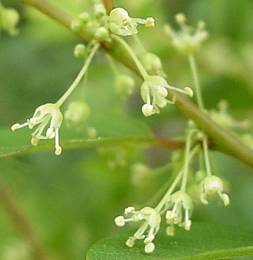Flueggea virosa
Flueggea virosa (Roxb.ex Willd.) Voigt
Family: Phyllanthaceae
Common names: white berry-bush (Eng.); witbessiesbos (Afr.); Mutangahuma (Tshivenda); Mpfalambati (Tsonga); Muhlakaume (Sotho)
SA Tree No: 309
Introduction
This African plant has become a problem plant in other parts of the world.

© Geoff Nichols
Description
Description
Flueggea virosa is a dioecious (male and female flowers on separate plants), multistemmed, fast-growing, bushy shrub, 2-3 m but sometimes a spreading tree up to 4 m high, with some small, thorn-like branches. The bark is reddish brown to brown. The leaves are green, crowded along the branchlets. It bears very small flowers which are creamy green. Fruit are white and fleshy and appear in December-March. Flowering time: October-January.

© Geoff Nichols

© Geoff Nichols
Conservation Status
Status
Flueggea virosa is not threatened but is not immune to future loss due to many factors. People from the Vhembe region in Limpopo often cut the living branches and dry them to make fire. Many plants are removed when clearing land for farming.
Distribution and habitat
Distribution description
Flueggea virosa is common in deciduous woodland and on forest margins, along rivers and in rocky areas. It is widely distributed in the southern Africa region. In South Africa it occurs naturally in Limpopo Province, Mpumalanga and KwaZulu-Natal. It also occurs in Zimbabwe and Tanzania. It can survive hot and dry areas and also survive mild frost. It has naturalized in Hawaii, Taiwan and in Haiku, Maui in China. It is currently a problem plant in these areas. In China it is known as Chinese waterberry.
Ecology
Ecology
A variety of insects such as wasps and bees pollinate the flower. Seeds are dispersed by animals and birds. The leaves are browsed by goats. It is also larval food for Charaxes butterflies.

Uses
Use
The slender branches are used to make fish traps. The small fruit is sweet and eaten by people, animals and birds when ripe. The roots and fruits are believed to be an effective snakebite remedy. Roots of this plant are also used in some African communities as contraceptives and for the treatment of syphilis, gonorrhoea, rheumatism, sterility, rashes, and an infusion of the root is taken to relieve malaria. The bark is believed to provide a treatment for diarrhoea and pneumonia.

Growing Flueggea virosa
Grow
The fruit must be cleaned and the small seeds dried. Sow the seeds at least within a month of collecting in a well-drained seedling growth medium. Germination is normally very good. It is a low maintenance plant that can grow without any extra feeding except watering at least once every second week. Once this plant is established, routine maintenance is unnecessary. It can be used for creating a soft screening and is ideal as a backdrop. It attracts birds and butterflies. It can also be used for creating a hedge or barrier.
References
- Coates Palgrave, M. 2002. Keith Coates Palgrave Trees of southern Africa, edn 3. Struik, Cape Town.
- Palmer, E. & Pitman, N. 1972. Trees of southern Africa. Balkema, Cape Town.
- Van Wyk, A.E. (Braam) & Van Wyk, P. 1997. Field guide to trees of southern Africa. Struik, Cape Town.
Credits
Tshifhiwa Ratshibvumo
(Co-authored by Thompson Mutshinyalo)
Walter Sisulu National Botanical Garden
October 2008
Plant Attributes:
Plant Type: Shrub, Tree
SA Distribution: KwaZulu-Natal, Limpopo, Mpumalanga
Soil type:
Flowering season: Spring, Early Summer
PH:
Flower colour: Green, Cream
Aspect:
Gardening skill:
Special Features:
Horticultural zones









Rate this article
Article well written and informative
Rate this plant
Is this an interesting plant?
Login to add your Comment
Back to topNot registered yet? Click here to register.